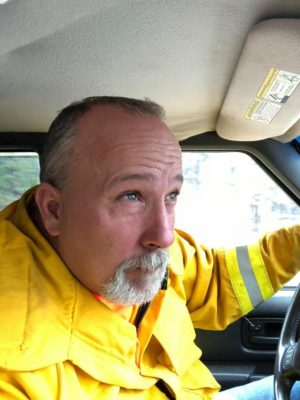
Dan Ryant’s travels through the north state have earned him a growing social media following.
Today aNewsCafe.com welcomes Dan Ryant, someone who’s developed an impressive social media following because of a few facets of his life. First, because he has a dump truck that he takes out on road construction jobs and clean-up after disasters, like fires, he’d take his camera and often reported what he saw in his travels, such as this one yesterday from Lakehead.
Second, he’s also know for his AWD broadcast, aka, “Adventures With Dan.” He enjoys volunteering and helping his community, and in a previous life chapter he was part of a search and rescue team, a fire department volunteer, an American Red Cross disaster services volunteer, CPR and first-aid instructor. Welcome, Dan! – Doni.
I had the most amazing day. I first caught footage of this train while it was fighting the Delta fire in northern Shasta County. I made contact with the crew, and two days later, I was invited aboard for a short journey and was given the opportunity to help fight the fire as part of the trip.
Several people had questions about the fire train – #FireTrain – so I thought I’d go get those questions answered. I ended up going for a ride on the train and got to fight the fire while on board.
There was a certain romance about the way the day went. The crew was outstanding. The weather was nice, yet smoky. The sound of the train’s horn and the vibration under my feet gave me a childlike chuckle going down the tracks. It had the same excitement boiling in my stomach as I did the first time I got on a mechanical horse in front of the market, when I was a kid. This felt like a childhood dream came true. Check one off the ol’ bucket list: VIDEO – TRAINS – FIGHTING FIRE.
Does it get better?
Here is what I found out about the train: Union Pacific has had this particular train since the late ’80s to early ’90s. It has three tankers attached to each other, which all feed to the last car, which is used as a firefighting platform. The suction from the pump pulls water from each car until they are all empty.
The “work train” as it is referred to by its crew, is readily available for duty at a moment’s notice — almost. The engine isn’t connected to it until it is ready to roll on a fire. Even so, the response time for this unit is impressively low. She can be coming around the mountain in less than 30 minutes, in many cases.

A Union Pacific fire train fights the Delta Fire. Photo by Dan Ryant.
The work train’s crew consider this apparatus as their pride and joy; one could say, “the pride of the Pacific”. Without this unit and its siblings, the rail system would be shut down during any fire that threatens the rail systems infrastructure. From railroad ties and slide fences to the signals, bridges, tunnels and crossing arms, safety is Union Pacific’s No. 1 priority. Being able to control a fire and protect their investment can be the difference between millions — if not billions in products — making it to their destination each day.
The unit is maintained regularly. In fact, each week its water supply is checked. The pump’s engine is checked for proper operation and fluid levels. It’s gone through until a clean bill of health can be issued. During the winter, it is stored and kept tucked away, nice and warm until spring.
Each year, this unit, as well as others throughout California, Oregon and Arizona, roll out on fires, equipped with a multiple, 500-gallons- per-minute hoses and nozzles. Capable of reaching 60 to 90 feet, they are ready to tackle the flames that threaten the rails.
Due to the fact that the rails transport so many different products, some of which are hazardous or flammable, they take no chances on rolling a train through a fire. Here’s a video I shot that shows how it works.
Interesting trivia: Ever wonder why engineers get all of the beautiful views at work? Why the rails seem to follow the streams and rivers? It’s because trains like a 1-to-2 percent grade when climbing. That’s about the same grade as most waterways. Also, when the rails were built, trains used steam to propel them. Having a river near by just made sense.
I’d like to extend a HUGE thank you to the men working on the rails. Thank you for the opportunity to join you at work, and for being such great hosts while I was on board. Also, thanks for helping America roll by risking your safety to keep the rails clear of fire.
#DeltaFire #unionpacific #firetrain
Click here to visit Dan Ryant’s Adventures With Dan Ryant Fire Information Facebook page.

